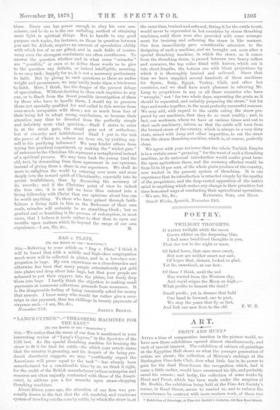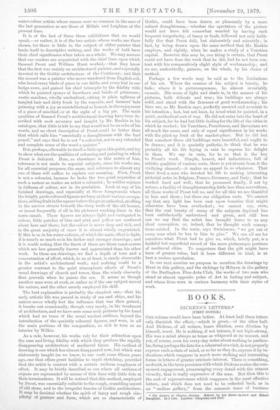ART.
PROUT AND HUNT.* Alma a time of comparative inaction in the picture world, we have now three exhibitions opened almost simultaneously, and each of special interest. The exhibition of cabinet oil-paintings at the Egyptian Hall shows us what the younger generation of artists are about ; the collection of Meryon's etchings at the Burlington Fine-Arts Club, does what little lies in its power to gain for the dead Frenchman the recognition which, had it come a little earlier, would have sweetened his life, and probably saved his reason ; and lastly, the collection of some works by Hunt and Prout, which has been made under the auspices of Mr. Ruskin, the exhibition being held at the Fine-Art Society's rooms, in Bond Street, serves to remind us, and to enforce the remembrance by contrast with more modern work, of those two
* Exhibition of Drawings, at Fine-Art Society's Galleries, 148 New Bond Street.
water-colour artists whose names were as common in the ears of the last generation as are those of Millais and Leighton at the present time.
It is of the last of these three exhibitions that we would speak,—or rather, it is of the two artists whose works are there shown, for there is little in the subject of either painter that lends itself to descriptive writing, and the works of both have their chief significance when taken as a whole. We may assume that our readers are acquainted with the chief lines upon which Samuel Front and William Hunt workeds—that they know that the first was mainly an architectural painter, and especially devoted to the Gothic architecture of the Continent; and that the second was a painter who never wandered from English soil, who loved every blade of grass in Our fields, and every leaf in our hedge-rows, and gained his chief triumphs by the fidelity with which he painted sprays of hawthorn and banks of primroses; rustic maidens, wholly tundealised, sitting in plain ugliness of tangled hair and dirty frock by the wayside, and farmers' lads grinning with a joy as unintellectual as honest, in the enjoyment of a piece of mischief, or at the sight of a big pie. The main qualities of Samuel Front's architectural drawing have been de- scribed with such accuracy and insight by Mr. Ruskin in his catalogue, that little is left to say that would not be an echo of his words, and no short description of Prout could be better than that which calls him "essentially a draughtsman with the lead pencil," and says that he is not "a colourist, nor in any extended and complete sense of the word a painter."
It is, perhaps, allowable to dwell a little upon this point, and try to show what are the qualities of colouring and painting in which Prout is deficient. Here, as elsewhere in this notice of him, reference is not made to especial subjects, since his works are, for all essential purposes, the same, and reference to almost any one of them will suffice to explain our meaning. First, Prout is not a colourist, because he lacks the two great requisites of such a nature as makes an artist a colourist ; he neither rejoices in fullness of colour, nor in its gradation. Look at any of his finished drawings, and especially at those foregrounds where the bright, parti-coloured figures are busy at their various occupa- tions, selling fruit in the square before the great cathedral, strolling in the narrow streets beneath the steep roofs of the old houses, or (most frequently of all in his pictures) washing linen in the town canals. These figures are always light and variegated in colour, little patches of blue and pink and yellow are scattered about here and there; but the colour is never deep and rich, and in the great majority of cases it is almost wholly ungradated. If this is so in his water-colours, of which the main effect is light, it is nearly as much so in his darker and stronger drawings ; and it is worth noting that the finest of these are those coast-scenes which are less generally known and appreciated than his other work. In these sea-drawings, we find a depth of tone and a concentration of effort, which, to us at least, is rarely observable iu the artist's architectural work ; and nothing could be a greater contrast to the quiet atmospheric efforts of Prout's usual drawings of church and tower, than the windy obscurity that prevails when he paints the sea. It seems as though another man were at work, or rather as if the one subject moved his nature, and the other merely employed his skill.
The best explanation is probably the simplest one,—that his early artistic life was passed in study of sea and ships, and his nature never wholly lost the influence that was then gained ; it breaks out occasionally, though very rarely, in his treatment of architecture, and we have seen some such pictures by his hand which had no trace of the usual washed outlines, beyond the introduction of the quaintly coloured figures, and were, in all the main portions of the composition, as rich in tone as an interior by Wilkie.
As a rule, however, his works rely for their attraction upon the ease and living fidelity with which they produce the rapidly disappearing architecture of mediaaval times. His method of drawing is one which ha e almost disappeared now, but which was elaborately taught (as we know, to our cost) some fifteen years ago, one that offers great facilities to rapid sketching, provided that the artist is content with a certain uniform roughness of effect. It may be briefly described as one where all outlines of objects are represented by means of thin lines with little dots at their terminations. It will be noticed that this method, employed by Front, was essentially suitable to the rough, crumbling aspect of old stone, and to the irregular fancies of Gothic architecture. It may be doubted whether the spirit of fancy and rough of gesture and form, which are so characteristic of Gothic, could have been drawn so pleasantly by a more refined draughtsman,—whether the spectators of the picture would not have felt somewhat wearied by having such frequent irregularity, of fancy or fault, followed not only faith- fully (for that Prout did), but elaborately and minutely ; in fact, by being drawn upon the same method that Mr. Ruskin employs, and rightly, when he makes a study of a Venetian capital. However this may be, one thing is certain, that Prout could not have done the work that he did, had he not been con- tent with his comparatively slight style of workmanship ; and we are, undoubtedly, gainers, on the whole, by his choice of method.
Perhaps a few words may be said as to the limitations of his art. Where the essence of his subject is beauty, he. fails ; where it is picturesqueness, he almost invariably suceeds. His sense of light and shade is, in the masses of his pictures, both delicate and true ; his buildings are always solid, and, stand with the firmness of good workmanship ; his lines are, as Mr. Ruskin says, perfectly assured and accurate to his intention ; last, but not least, he loved what he painted, in a quiet, methodical sort of way. He did not enter into the heart of his subject, for be had. but little feeling for the life of the cities in which he worked ; his Venetians, Frenchmen, and Bavarians are all much the same, and only of equal significance in his works with the piled-up fruit of the market-place. But he did feel that somehow these old buildings were beautiful, and ought to be drawn ; and it is quaintly pathetic, to think that he was probably all his life trying in vain to express his delight in them. We say in vain, for to us that is the key to Prout's work. Simple, honest, and industrious, full or artistic qualities of various sorts, there is yet absent from it the vivifying element,—it makes no appeal to us whatever. That there lived a man who devoted his life to making interesting pictorial notes in Belgium, France, Germany, and Italy ; that he- worked hard and well ; that he possessed finally, if not by nature, a facility of draughtsmanship little less than marvellous, all these works of Prout tell us, and for all this we are thankful to him and them ; but there our obligation ends. We cannot say that any light has been cast upon beauties that might otherwise have been overlooked ; we cannot say, even, that the real beauty of many of the subjects depicted has been satisfactorily understood and given, and still less can we say that the artist has brought home to us any ideal conception, or, indeed, that he thought such concep- tions existed. In the main, says Swinburne, "we get out of every man what he has in him to give." We can all see for ourselves what Front had to give us, which, briefly put, is a faithful but superficial record of the more picturesque portions of mediu3val cities. To conjecture that the gift might have been of greater value, had it been different in kind, is at best a useless speculation.
In our next number we purpose to mention the drawings by Hunt in this gallery, and the etchings by Meryon in the gallery of the Burlington Fine-Arts Club, the works of two men who stand at almost opposite poles of Art in feeling and subject, and whose lives were in curious harmony with their styles of work.



































 Previous page
Previous page